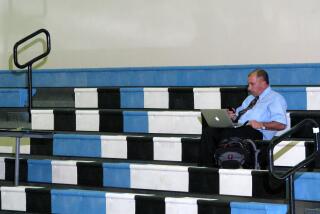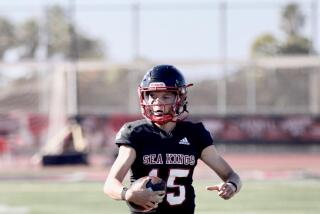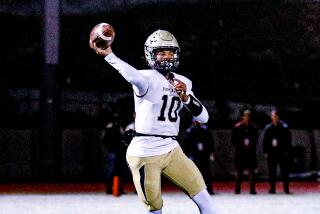Anthony Conyers: : He Needed Time to Catch On
SAN DIEGO — Through the years, San Diego State has almost always had a future pro such as Gary Garrison, Haven Moses, Isaac Curtis or Webster Slaughter.
Those were the big-play receivers, the ones the Aztecs could count on to make the receptions in game-determining situations.
Until two games ago, the 1986 Aztecs were a team in search of the missing receiver. Nobody had emerged as the focal point in crucial situations.
But suddenly, senior Anthony Conyers has become the receiver extraordinaire . He has caught 13 passes in the last two games, all for first downs and including four in a last-minute touchdown drive that beat Colorado State.
Maybe the question shouldn’t be why Conyers has surfaced as a primary receiver. Why he hasn’t come to the top sooner?
Doug Scovil, former SDSU coach, considered Conyers among the top two or three recruits before the 1984 season.
That wasn’t hard to figure since Conyers had caught 40 passes the year before at Los Medanos College in Pittsburg, Calif., and ran the 40-yard-dash in 4.4 seconds.
Yet from the time Conyers entered SDSU, circumstances have kept him well away from the limelight.
In 1984, the Aztecs had Slaughter, Vince Warren and Austin Shanks as wide receivers. Scovil decided to redshirt Conyers.
Though Slaughter and Warren returned in 1985, Conyers actually beat Warren in spring practice.
However, Conyers had fallen behind in school and needed a “B” in a summer school class to retain his eligibility. He got the B, but he lost his starting position by missing practice because of summer school.
Conyers ended up with only one reception for six yards in 1985.
The appointment of Denny Stolz as coach meant a second chance for Conyers.
“I was really excited, to say the least, about the coaching change because of what had happened in the past,” Conyers said. “I figured my future was pretty much stagnated with the old staff because of the conflicts that had already occurred.”
Stolz helped Conyers’ confidence the first time they met.
“I just told him he certainly had the talent to play a lot,” Stolz said. “I had no idea why he hadn’t been playing, and I didn’t care. As far as I was concerned, we were starting all over.”
Yet, when the season began, Conyers wasn’t starting. He and Alfred Jackson were frequent substitutes for starters Brett Blanchard and Kenny Moore.
In the first seven games, Conyers caught 11 passes for 207 yards and 2 touchdowns. In the last two games, he has started and caught 13 passes for 252 yards and a touchdown. Starting evidently make a difference.
“Those are things you have to learn in time as you coach the team,” Stolz said. “I didn’t know this team when I came here. Anthony is a perfect example. The more he plays, the more he gets the ball and make things happen.”
Conyers started playing Pop Warner football when he was 7 because he wanted to emulate his brother, Dennis, who was six years older.
The Conyers moved five times during Anthony’s childhood because his father, Joseph, was department chairman for a computer programming company. Every time the family moved, Anthony immediately sought a football team to gain his peers’ approval.
“I made friends because I was always good,” Conyers said. “I was always shy when I was young, too. I didn’t meet people just by talking, so I always joined sports teams.”
When Conyers was 15, the family finally settled in Concord, Calif., where he made the Clayton Valley High School football team and was the most valuable player his senior year, catching 22 passes in a wishbone-oriented offense.
At Los Medanos, Conyers went out for football because “I thought I would have 50 friends right away by playing.”
He caught 22 passes for 430 yards as a freshman and 40 passes for 719 yards as a sophomore.
The recruiters, who had ignored him out of high school, suddenly were interested. Conyers visited Utah, San Jose State and Arizona before selecting SDSU.
“When I was young, I had a sister who went to San Diego State,” Conyers said. “When I visited the campus one day to see her, they had shops set up and it was really sunny. I fell in love with this campus. When I was older, I found San Diego State was a passing team. That helped solidify my choice of San Diego State.”
However, it took nearly three years--and two coaches--for Conyers to solidify himself as a starting receiver.
“We’re still a passing team, but if you look at the statistics, we don’t pass as much as in the past,” Conyers said. “Our offense is designed differently than before. Our receivers are not the focus of the offense like they used to be.”
Aztec Notes
Before the season, Coach Denny Stolz said he wanted to erase a defeatist attitude the Aztecs seemed to acquire after three consecutive losing seasons. “Our players are very confident now,” Stolz said. “They don’t see the difference I do. They think their intensity is the same. Their pregame, game and postgame habits are much better than they were.” SDSU, which plays at home Saturday night against Hawaii, needs to beat Hawaii and Brigham Young to win the Western Athletic Conference championship. . . . Quarterback Todd Santos was sacked 4 times for 40 yards in Saturday’s 31-24 victory over Wyoming. “We have a lot of work to do in our offensive line,” Stolz said. “We have had a number of very crucial injuries there and need to solidify that group. We need to protect the quarterback a little better than we did last week.” Offensive tackle Mike Ariey, who will miss the remainder of the season following knee surgery two weeks ago, is the only Aztec not expected to play against Hawaii.
More to Read
Go beyond the scoreboard
Get the latest on L.A.'s teams in the daily Sports Report newsletter.
You may occasionally receive promotional content from the Los Angeles Times.










